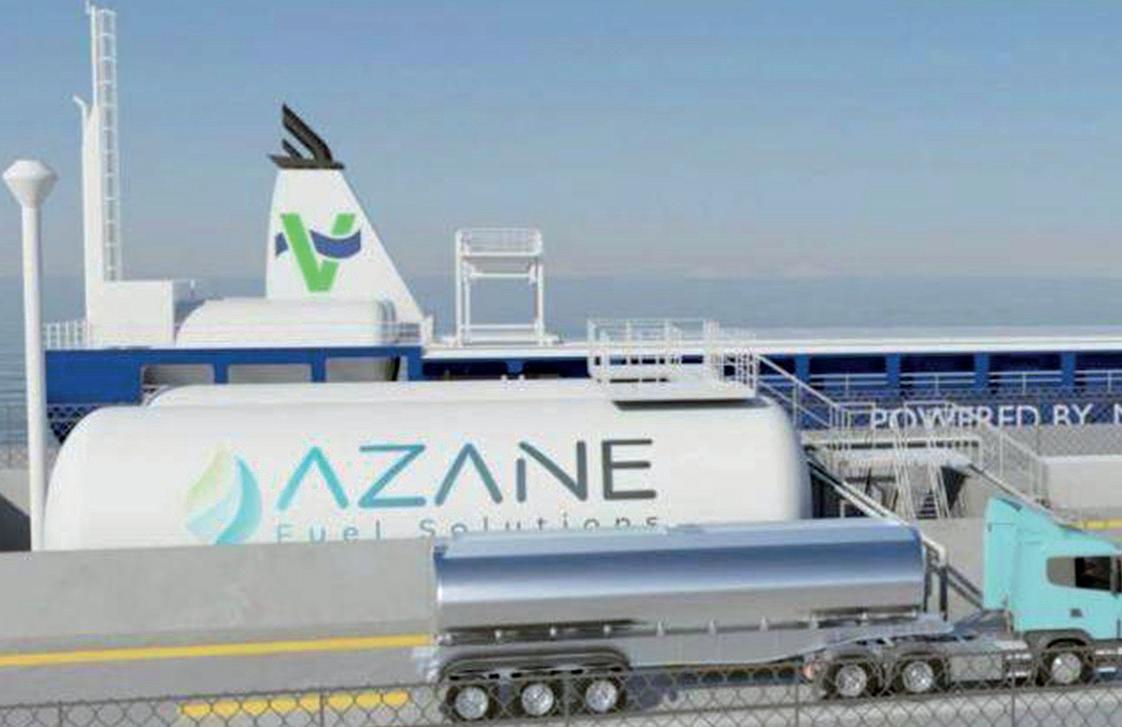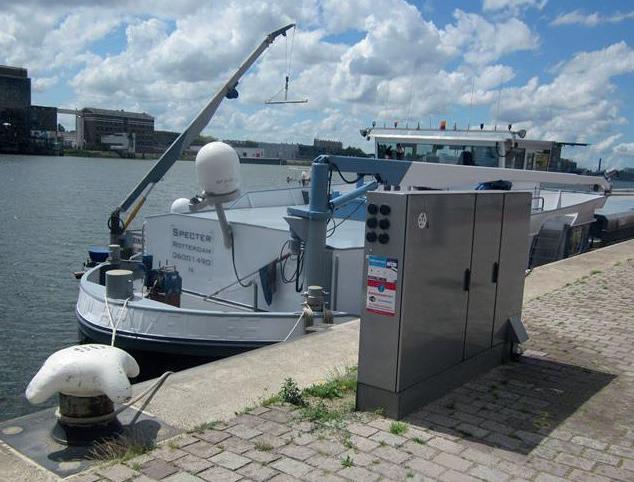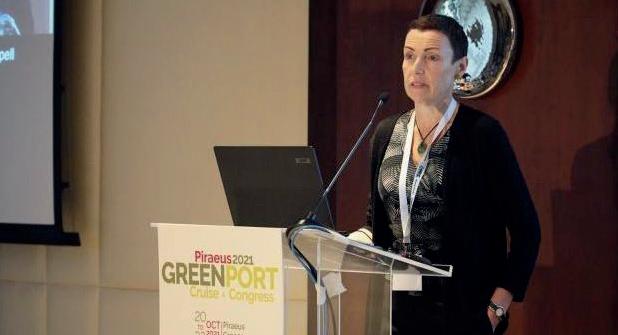
7 minute read
Congress Review
FUTURE FUELS: CHANGING THE FACE OF THE INDUSTRY
GreenPort Cruise & Congress 2021 hosted by the Port of Piraeus or exceeded the expectations of the majority of the industry. Here are some of the exclusives gained at the event, by news reporter, Rebecca Jeffrey
Ammonia investment challenges
Ammonia needs to be treated with caution but has valuable green credentials.
Speaking exclusively to GreenPort, Malte Siegert, head of environmental policy at Naturschutzbund Deutschland (NABU) said that while ammonia use comes with safety concerns, green ammonia has zero emissions and is therefore an attractive development prospect.
“Ammonia has no carbon and you don’t have to have any after treatment, which makes it most likely cheaper to use.” Money plays a very important role in the energy transition, he pointed out. “There are safety aspects that have to be dealt with in the ports, but you can use ammonia for fuel cells, therefore it seems to be a very good thing,” Mr Siegert said.
Aiding green hydrogen
Ammonia demand comes to the fore when looking at the challenges of using more green hydrogen and how this can be financed. “The biggest problem is to produce the ammonia needed for hydrogen because in the future everybody wants it. If hydrogen is also the base for other e-fuels then you need it in a huge amount,” stressed Mr Siegert.
Establishing production sites that produce enough hydrogen to supply the whole maritime industry, and also other sectors where it is in demand remains to be seen, he said. “We have lots of hydrogen, but not green hydrogen, so it’s important to produce it in a way that it’s sustainable.”
Is methanol a winner?
Although ports have been working on safe LNG handling for years, and have extended their learnings to other fuels, the dangers of ammonia shouldn’t be underestimated, said Mr Siegert.
“The bad thing is it’s so toxic - it has an impact on the marine environment. There have always been solutions for flammable and toxic goods in ports, and the good thing is ammonia doesn’t last as long as HFO in water, but you cannot avoid the outcome of an accidental spill in the instance of it being used as a shipping fuel.”
Ammonia appears difficult to handle and it’s doubtful that it will be used for large-scale applications, said Mr Siegert. Instead, it might be better to focus on methanol development.
“There might be some specific areas where it is used, but for a larger scale application I doubt it, methanol might be the better thing because you don’t have to cool it down.”
8 Azane Fuel
Solutions’ ‘Ammonia Fuel Bunkering Network’ project aims to develop, build and operate a green ammonia bunkering terminal
Electric grid challenges
Shore power investment is more widespread than ever, but can ports handle electric grid challenges?
Capacity is one of the biggest concerns for ports offering onshore power supply (OPS), as shipping companies embrace decarbonisation and both shore power-enabled and battery-propelled ships increase in numbers, said Alex Ruijs, senior consultant for electrical power and energy within the water & maritime team at Royal HaskoningDHV.
Speaking exclusively to GreenPort, Mr Ruijs explained: “The challenge for shore power is that we will have more and more ships with batteries onboard that are used for propulsion.”
As battery systems advance and ships are able to sail for longer on batteries, these ships are recharging at ports, which can surge the shore power system.
Larger ships running on batteries will mean more OPS consumption. Currently OPS for container ships are rated for 8MVA maximum. Ships in most cases do not require more than 5MVA but as bigger ships with batteries emerge, OPS at ports will need to have more power output, Mr Ruijs explained.
“Shore power systems will need to have more power output in the future as demand increases. They might need to be redesigned because of this,” he said.
Though ship batteries require significant grid power, battery packs are a sound investment for ports looking to secure a backup to the grid.
In the Netherlands, grid suppliers have a fixed price for grid connections up to 10MVA and electricity needs to be offered obligatorily. In countries where grid operators call the shots this isn’t the case, other solutions are needed like battery chargers. “Redundant capacity in the grid is one of the cheapest solutions but has limitations in the instance of a failure or maintenance issue,” Mr Ruijs pointed out.
He explained: “The battery pack can be charged when there is a low demand for shore power and demand is lower than the maximum capacity of the grid connection. When it’s the
opposite, the battery is discharged and the battery can, during a limited period, provide the additional capacity required for shore power.”
While battery packs are a reliable power solution, cost is a major consideration. Battery packs can increase the total cost of shore power investment by 20-50%, said Mr Ruijs.
Total cost depends on the capacity of the shore power system in relation to the capacity of the grid connection – the larger the difference, the higher the cost. Spatial impact and a safe place to store the batteries are other concerns when large scale battery back-up systems are considered.
Port of IJmuiden
The Port of IJmuiden in the Netherlands is a good example of a successful shore power installation, said Mr Ruijs.
“With a capacity of 250kW per ship and a total system capacity of 1MVA it was cost efficient to increase the capacity from the grid supply instead of using a battery storage system.” He added: “The Port of IJmuiden shore power system is intensively used and works without practical problems. Since 2006, several ports in the Netherlands have installed effective shore power for barges with multiple low-capacity connections.”
LNG remains relevant
LNG remains a core fuel that is cautiously being invested in by one cruise industry operator.
Despite heated industry debate about how relevant LNG is with 2050 zero emissions decarbonisation targets looming, MSC Cruises believes it is a valuable fuel with capacity for transition.
“We made this decision because we would have an immediate and substantial emissions saving. But LNG wasn’t just about the carbon, it’s also about the local air quality,” Linden Coppell, director of sustainability at MSC Cruises, told GreenPort. The reason for LNG is because it’s available, it’s available at the scale we need and it eliminates most of the local air pollutants.”
Transition potential
Additionally, MSC are confident LNG is a transition fuel. “We could not have invested the amount we have without thinking that there’s going to be a future bio/synthetic substitute that we can transition to, explained Ms Coppell.
MSC is already researching bio-LNG in the market and will be supported by its partners, including Shell.
Three of its ships on firm order are LNG, including the first of MSC’s world class series of ships, but with regards to future LNG ship orders, MSC remains cautious about how future fuel investments across the industry will unfold and doesn’t want to risk “stranded assets”.
Ms Coppell reflected: “Because of the landscape with regards to decarbonisation and the regulatory and political environment it’s becoming so strong in that move towards zero emissions, we’re really having to say, let’s wait and see how this technology plays out.”
Fuel contenders?
Dual fuel engines will offer the confidence to invest in fuel where security of supply in unknown, she said. Though in a nod to what might be next, Coppell said hydrogen is probably one of the biggest long term potential fuels, but it does need to be green hydrogen.
E-methanol or bio-methanol could also potentially be mixed with regular fuel, noted Coppell. Though, ideally the company need to do as little modification as possible and

8 A barge connecting to shore power at the Port of Rotterdam
this involves working with engine manufacturers to see them developing advanced combustion engines that will enable more flexible fuels to be used, including zero emission fuels.
On the subject of financing future ships on the decarbonisation pathway, Ms Coppell said there is likely to be more pressure from bank lenders to make sure that investments are in low carbon/carbon free vessels.
“I think that will be a big driver for us. We invested much more in LNG ships than we would have done on traditionally fuelled ships, so we’re willing to take that hit and we know we’re going to have to in the future.”
8 Linden Coppell,
Director of Sustainability, MSC Cruises










